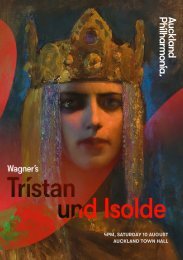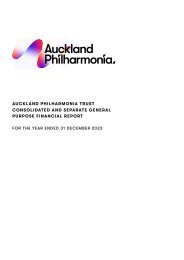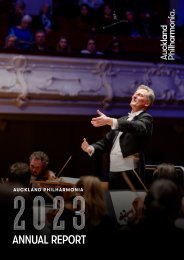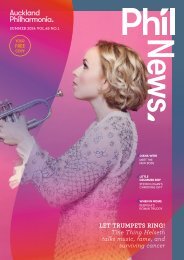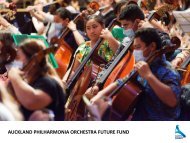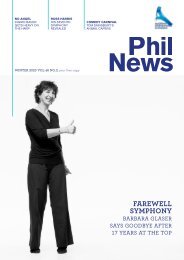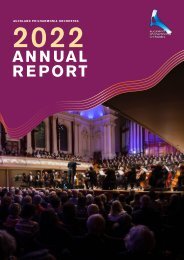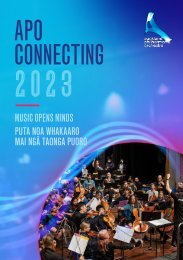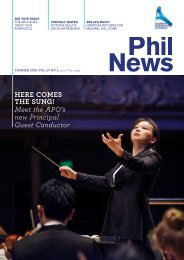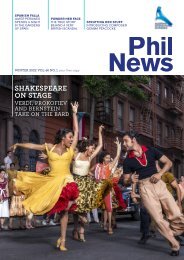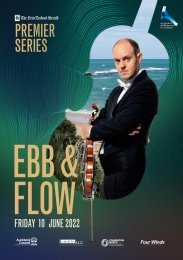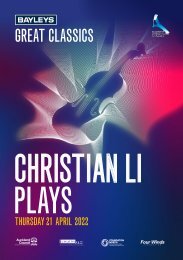Create successful ePaper yourself
Turn your PDF publications into a flip-book with our unique Google optimized e-Paper software.
THE<br />
REVOLUTIONARY<br />
LISTENING NOTES<br />
FOR NEW LISTENERS<br />
CONDUCTOR Giordano Bellincampi<br />
BEETHOVEN Symphony No.6 ‘Pastoral’<br />
BEETHOVEN Symphony No.7
LUDWIG VAN<br />
BEETHOVEN<br />
(1770 – 1827)<br />
COMPOSER PROFILE<br />
• Ludwig van Beethoven was a German composer and<br />
pianist.<br />
• His earliest composition is a set of nine piano variations,<br />
composed in 1782 (he was 12 years old).<br />
• He moved to Vienna in 1792, where he first met Haydn.<br />
• By 1796, he had begun to start losing his hearing.<br />
• <strong>The</strong> Third Symphony, known as the ‘Eroica’, was<br />
completed in 1804 and redefined the symphony and the<br />
genre's expressive capabilities.<br />
• Beethoven’s Ninth Symphony, the ‘Choral’ was the first<br />
time a composer used choral voices in a major symphony.<br />
SYMPHONY NO.6 ‘PASTORAL’<br />
“No one can love the countryside as much as I do.”<br />
Ludwig van Beethoven<br />
This Symphony consists of five movements:<br />
I. Allegro ma non troppo (fast but not too fast)<br />
(Awakening of happy feelings on arriving in the<br />
country)<br />
<strong>The</strong> first movement establishes an idyllic mood and<br />
opens with a direction in the score that it should be<br />
played “cheerfully, but not too fast.” <strong>The</strong> first and second<br />
violins play a simple theme, which provides the basis of<br />
the movement. <strong>The</strong> main motif consisting of a skipping<br />
rhythm, is heard throughout this movement creating the<br />
image of village children at play.<br />
II. Andante molto mosso (moderately slow)<br />
(Scene by the brook)<br />
<strong>The</strong> second movement opens with the violins creating a<br />
watery soundscape. This theme is developed and<br />
extended, and the ending recalls the opening themes<br />
(now with more<br />
instruments added.) <strong>The</strong> movement comes to an end<br />
with the chirping of a nightingale (flute), quail (oboe), and<br />
cuckoo (clarinet).<br />
III. Allegro (fast and playful)<br />
(Merry gathering of peasants)<br />
<strong>The</strong> third movement has human inspiration, with a playful<br />
theme depicting the heavy foot stomping of an Austrian<br />
country dance. This movement ends by gradually getting<br />
faster and faster, with the whole orchestra playing loud<br />
accents.<br />
Immediately with no break to:<br />
IV. Allegro (fast) (Thunder & Storm)<br />
<strong>The</strong> movement starts with the low strings imitating the<br />
distant thunder. <strong>The</strong> musical tension starts to build, and<br />
later climaxes to a very loud section with all the whole<br />
orchestra playing together. Timpani and low strings create<br />
the sound effect of a heavy thunderstorm, which builds up<br />
to the addition of the trombones and the shrill whistling of<br />
the piccolo.<br />
When the thunderstorm subsides and is replaced by<br />
the sunshine, the brass and timpani fade away, and<br />
instrumentation returns to the woodwinds and strings of<br />
the first movement as the peaceful pastoral scene returns.<br />
Immediately with no break to:<br />
V. Allegretto (light, graceful, and moderately fast)<br />
(Shepherds hymn – happy and thankful feelings<br />
after the storm)<br />
This movement is a pastoral folk tune played by clarinet<br />
and horn supported by the low strings. <strong>The</strong> first theme<br />
is stated three times, each one gradually fuller in its<br />
orchestration. <strong>The</strong> second and closing themes are<br />
ornamented with trills and short note figures that suggest<br />
the birds of the first two movements coming out from their<br />
hiding places after the storm.<br />
2
SYMPHONY NO.7<br />
<strong>The</strong> Seventh Symphony was premiered in Vienna<br />
in 1813, and was a part of a charity concert for<br />
soldiers. This concert was arguably the most<br />
successful in Beethoven’s lifetime.<br />
Beethoven himself conducted the concert, and we must<br />
remember that by then, he was profoundly deaf, and he<br />
couldn’t hear the piano passages at all. German composer<br />
Louis Spohr describes Beethoven’s conducting from his<br />
memories of playing violin in these concerts:<br />
“Beethoven had accustomed himself [he says] to indicate<br />
expression to the orchestra by all manner of singular bodily<br />
movements. At piano he crouched down lower and lower<br />
as he desired the degree of softness. If a crescendo then<br />
entered he gradually rose again and at the entrance of the<br />
forte jumped into the air. Sometimes, too, he<br />
unconsciously shouted to strengthen the forte. It was<br />
obvious that the poor man could no longer hear the piano<br />
of his music.”<br />
It has four movements:<br />
I. Poco sostenuto – Vivace<br />
(Rather sustained – very fast)<br />
<strong>The</strong> first movement starts with the longest introduction<br />
to any of Beethoven’s symphonies. It is over three<br />
minutes long and previews the keys of the four coming<br />
movements.<br />
After this extended introduction, the movement jumps<br />
in tempo to very fast with a rhythmical and driving motif.<br />
Again, Beethoven uses one of his defining characteristics,<br />
silence, to create dramatic effect and suspense. Another<br />
feature of this movement is Beethoven’s use of ascending<br />
and descending chromatic scales starting in the bass.<br />
Finally, Beethoven bookends the first movement with its<br />
introduction and ending, both of exactly the same length.<br />
II. Allegretto (light, graceful, and moderately fast)<br />
<strong>The</strong> second movement is a melancholy march and<br />
has been very popular since its premiere in 1813, with<br />
audiences often wanting an encore of this movement<br />
before continuing to the remaining movements. This<br />
movement includes a theme and its variations. Beethoven<br />
further develops the theme by turning it into a fugue. As<br />
with the first movement, the second movement features a<br />
driving rhythm that is consistent throughout.<br />
<strong>The</strong> movement closes by returning to the main theme<br />
while gradually reducing the number of instruments<br />
playing and fragmenting the rhythmic motif. <strong>The</strong><br />
movement ends with a fading chord in the winds.<br />
III. Presto (playful and extremely fast)<br />
<strong>The</strong> main theme of this movement is stated first by<br />
the strings and woodwinds and later passed around<br />
various sections. Beethoven injects some humour into<br />
this movement with the use of a repeated two-note<br />
descending gesture. This motif is stated throughout<br />
the orchestra, creating a dreamy effect shaken awake<br />
by a very loud outburst. <strong>The</strong> middle section opens with<br />
horns, clarinets, and bassoons playing a simple theme<br />
over a long sustained note. This section builds as the<br />
orchestration and volume grows until the timpani brings us<br />
to the climax. <strong>The</strong> middle section is repeated in full, and,<br />
once again, Beethoven uses humour to begin it a third<br />
time at the end of the movement, only to end it quickly<br />
with a loud cadence.<br />
IV. Allegro con brio (Fast with vigour)<br />
This movement opens with whole bars of silence and also<br />
has a driving rhythm. <strong>The</strong> first theme is accented by loud<br />
notes on the second beat. A skipping rhythm introduces<br />
the second theme. A very long sustained note, with a<br />
gradual increasing of volume to very, very loud or fff, the<br />
first marking of its kind in Beethoven’s symphonic works.<br />
INTERESTING FACT<br />
Beethoven was completely deaf by his mid-forties. A<br />
young musician named Ferdinand Hiller snipped off a lock<br />
of hair from the composer’s head as a keepsake, which<br />
was a common custom at the time. It was passed down<br />
through generations, and eventually, a collector purchased<br />
the hair and was interested in finding out why Beethoven<br />
became deaf. <strong>The</strong> hair was DNA, chemical, forensic and<br />
toxicology tested. <strong>The</strong> results showed very high lead<br />
levels, potentially indicating chronic lead poisoning, which<br />
could have caused Beethoven’s deafness.<br />
FUN FACT<br />
No one is sure of the exact date Beethoven was born.<br />
Beethoven himself thought he was born in 1772.<br />
However, it is thought that his father had deliberately<br />
made Beethoven appear younger than he was, so he was<br />
thought of as a child prodigy.<br />
Beethoven uses ascending and descending scales, as he<br />
did in the first movement, in the melody of the theme and<br />
variation, it is played by the cellos and violas.<br />
3



